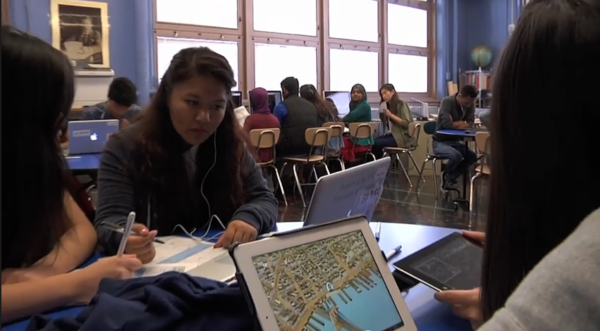Process and Development

Overview of the Development Process
The development of each Mission US game and its companion educational materials involves a complex collaboration between four key partners and incorporates critical input from historians with expertise in each era, community stakeholders, diverse young people, and educators.
Since our initial pilot development beginning in 2005, WNET has collaborated with a multidisciplinary team to create Mission US. Reflecting the latest academic scholarship, the history content for each mission is developed by a team of historians at the American Social History Project/Center for Media & Learning (ASHP), a research center at the City University of New York, Graduate Center. We also consult closely with advisors, including scholars and community stakeholders with expertise concerning the historical circumstances that are the subject of each game, as described below. Throughout the development process, researchers from the Education Development Center’s Center for Children and Technology (CCT) conduct focus group testing with diverse groups of students and teachers that helps the game development team identify and address misconceptions about the content each mission explores. The game developer is Electric Funstuff (EFS), a company with extensive educational technology experience.
Further Detail on the Development Process
At the start of each mission, historians and educators from ASHP develop a detailed content document that includes educational goals spanning all project components and suggests key primary source documents, vocabulary, historical figures, and events. With input from advisors (including scholars and community stakeholders), the team then jointly develops the narrative outline, including characters, locations and game features.
During this early phase, CCT conducts an initial focus group with educators and students to assess areas of need and common misconceptions around the mission’s topic. Depending on the mission’s subject matter, the team may also meet with stakeholders in relevant communities. For instance, for “A Cheyenne Odyssey,” the team met with representatives of the Northern Cheyenne Tribe at Chief Dull Knife College, a tribally-managed institution on the Northern Cheyenne reservation in Montana, who later consulted on educational content, scripting, design, and casting for the game. For the upcoming “Prisoner in My Homeland,” which focuses on the WWII incarceration of Japanese Americans, the team met with the Bainbridge Island Japanese American Community as well as historians at the Densho archive and at the Manzanar National Historic Site, who would continue to advise on the content, scripting, and design of the mission. For the mission currently in development about the civil rights movement, the team met with former SNCC activists to solicit input from their personal experiences as young people organizing protests in Mississippi in the 1960s.
Once the game narrative is finalized, EFS collaborates closely with ASHP and WNET to draft the game’s intricate dialogue scripts, with ongoing review and input from advisors. EFS then creates the game’s visual designs and develops the interactive programming for the entire mission, including all of the branching dialogues, custom minigames, and the badge system — all with regular review and input from ASHP, WNET, and advisors. Throughout the process, CCT conducts informal testing of designs, scripts and game approaches with students and teachers for appeal and usability.
Meanwhile, WNET and ASHP will work with curriculum consultants and advisors to develop a comprehensive curriculum guide for each mission, to support educators in using the games with their students.
The Mission US team very much values the input of educators, parents, and students as we develop content for new missions. If you would like to provide feedback and/or are interested in helping to test and evaluate new missions in development, please contact us at missionus@thirteen.org.